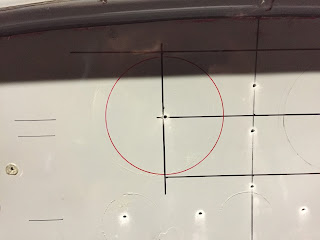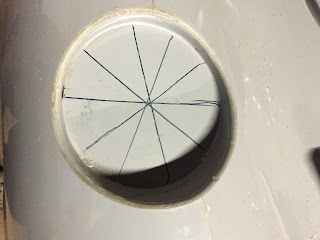I have managed (with the help of AK!) to get to the momentous stage of applying for the IVA test.
For most people that undertake the building of a machine as complex as a car that is legal to drive on the road, it would seem that the IVA application is the most confusing part of it all.
In my opinion, this is not made any easier by the "non-English" English that DVSA use in many of their forms and guidance documents!
So, I thought it might be useful to document my experience to help the many people that will follow me on this path.
Before I document my experience, I also found Ant's blog very useful and he also has a page on the actual application forms which is very useful and details the forms that need to be completed.
Ant's Cobra IVA Page
(be aware that there are thumbnails of the "IVA 1C" form, and it looks like page 3 is duplicated, but if you click on the 2nd thumbnail it actually opens a picture of the 2nd page)
I will not duplicate that effort here, so you can read this for yourselves and I will try and fill in my experience of the process.
Here is the list of files that I submitted:
This includes the following:
- IVA 1C form - main application form
- IVA 4 Amateur Built Declaration form
- 17 pictures taken throughout the build - this blog helped a lot!
- 8 receipts for items bought throughout the build - most importantly
- The receipt for the chassis/kit from the manufacturer showing the VIN
- Gearbox receipt
- power steering rack receipt
- V5 for the donor vehicle
- I did not have a receipt for this, and did not submit one and this was not an issue
- Engine Age Certificate
You will note that all of the files except the DVSA forms are "JPG" files as I did not have scans of them and could only use photos taken from a smart phone - this did not seem to be an issue for DVSA and did not cause any delay to the application.
I also names all the files with the VIN number to try and help keep all the documents together.
I submitted the application online using DVSA's TAS system: www.gov.uk/dvsa
There is a single upload field for the IVA 1C form, and then all other files are uploaded to the second upload area - you have to upload one file at a time, but I had not issue uploading them all. I know some builders have said they could not upload everything (not sure why), but once you have you application reference number you can simply email DVSA with any additional documents using that reference number.
Once you have uploaded and submitted the documents, you will receive an automated email from the TAS system stating the following:
Thank you for your Technical Test Application 1/AKG2CPBxxxxxxxxxx.Your reference number for this application is TAS 3xxxxx. If you wish to provide any further information in support of your application then please use your email software's 'Reply' function and leave the subject line unchanged.
This did not come through immediately so I assume is based on some automated system timing.
After 5 days, I got another email from the TAS system with the subject "[TAS 3xxxxx] - Application Assessed".
The content of this email was as follows:
Dear Applicant
Your application for Individual Vehicle Approval is now ready for payment.
NOTE: If you have not already done so, you can make payment for your application and book your test appointment, where appropriate.
Vehicle Identification Number: AKG2CPBxxxxxxxxxx
If paying by Pre-Funded account, the test fee will be debited accordingly and the transaction will be shown on your monthly statement.
If paying by Credit/Debit Card, please contact us as soon as possible on 0300 123 9000 and select Option 1(from 07:30 to 18:00, Monday to Friday), with your TAS ID number to make a payment. If you have nominated a DVSA testing facility for your IVA, MSVA, or Coif Scheme application you will also be able to book a test appointment.
Please Note: [1] If you have submitted an HGV or Trailer Technical Application which requires an inspection you will be contacted shortly.
[2] If payment is NOT received within one month this may result in your application being cancelled.
NOTE:*** Changing Vehicle Approval test appointments ***From 1 July 2019, we will be changing the way you can change test appointments you have made.You can only change the appointment twice, and you must do it before midday on the working day before the appointment.You won't be able to change it a third time.In addition, you can get a different vehicle tested at an appointed time, provided:• both vehicles already have an appointment booked• the appointment is booked using the same prefunded account, or by the same applicant if paying by card• the vehicle is the same test category with the same test durationIf you don't bring the vehicle to the third appointment you make, the relevant cancellation policy will apply.Any test appointment changes DVSA has to make due to unforeseen circumstances will not be counted as part of your test allocation.
Yours faithfully
Customer Service Centre TeamDriver and Vehicle Standards Agency | The Ellipse Building, Padley Road, Swansea, SA1 8AN
I excitedly phoned up almost straight away (which is odd as the next part makes you £450 poorer!) and paid my money - I did not book a test date at this point as AK are presenting the car for the test so they will arrange this directly.
I was told on the phone that I would receive an email receipt and that was the application complete.
This made the next email received a bit confusing, which was another reason I wanted to write this.
The next email was from "VOSA_ADMIN", it was received about 1.5 days after calling up to pay and the subject was "Your recent application for Booking Ref:1-xxxxxxxxxx":
Dear MARK HARNETT,
Thank you for your recent application for a IVA BAS M1 CAT.A,C,S TEST for your vehicle/trailer. Due to the nature of your booking this has been referred to the DVSA Testing and Support Services (TaSS) in Swansea. You will receive email confirmation once your application has been processed.
Terms & ConditionsPlease visit our website at https://www.transportoffice.gov.uk/crt/doitonline/bl/help/etbtermsandconditions.htm for more details.
Thank you,
DVSA
As stated, I was confused by this - they make it sound like there is something out of the ordinary with the application and it has been referred to Swansea. By this time the office had closed so I could not call up to query it, so I decided to do that first thing in the morning - I had also not received an emailed receipt.
When I woke in the morning, I had the emailed receipt, so was a little more at ease, but decided to call up anyway.
The answer was that this was all normal, and the referral is just the application being released to the next stage and it was ready for the test to be booked.
This is as far as I have got and now waiting for AK to book the test! I hope this has been useful to someone.



































